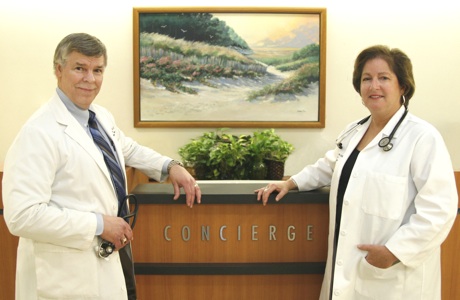

The Virginia Beach Premier Medical NewsletterMarch, 2012
VBPM Connection is a newsletter published by Virginia Beach Premier Medical, an internal medicine practice dedicated to personalized, highly attentive, high quality care for our patients. The newsletter provides information of a general nature about our office, current health news and various common illnesses and ailments. None of the information provided is meant to be specific for any particular individual. Always seek the advice of your personal physician for any specific information about your health.
Achieving a Healthy Weight
Achieving and maintaining a healthy weight is one of the most effective things you can do to assure a healthy future.
How do you know if you have a problem? Some people think they are too heavy even when they're not. Some are overweight and don't know it or don't think twice about it.
The first thing to do is to determine if you need to lose weight. If you’re not sure, one way to find out is to determine your body mass index (BMI) and see if you fall into a healthy weight category, based on the recommendations by the National Institutes of Health. Your doctor can help to determine if your BMI is in the right range. The BMI may not always be accurate. You may have a high BMI, for example, because you are very muscular due to lots of exercise. In this case, the high BMI may not be a problem.
The second thing to do is to measure your waistline. If your waist is greater than 35 inches for women or more than 40 inches for men this definitely increases your risk for future problems.
If you are truly overweight, there are basically only 3 factors that will get you on the road to recovery. The first thing to do is to examine your current diet and change it so that it is healthier. The majority of your diet should consist of vegetables and fruits. You should be eating fewer fats and very little sweets. Control your portions carefully. Eat breakfast every morning. Replace calorie-containing beverages with water. Count your caloric intake and make sure that it is less than 1500 calories per day (Don't guess!)
The second most important thing to do is to increase your physical activity If your life is relatively sedentary, you need to make changes. Start out with mild amounts of exercise every day such as walking. Try to vary the exercise on different days. For example, walk 3 days a week, and lift small weights or use stretching bands on the other days. Gradually increase the activity as you can tolerate it - up to at least 30 minutes every other day. The important thing is to do something, anything, just to get started, and then try to make it a routine, and a priority.
The third factor that you need to have to lose weight is motivation. You will need to want to do this for yourself before it will work. You have to get yourself in the right mind-set. Try to determine why you want to lose weight. What are your goals? Do you want to be healthier, live longer, look better - all the above? Psych yourself up about it and stay focused on your goals.
There will be obstacles (a.k.a., excuses) that will seek to prevent you from reaching your goals. Use your problem-solving skills to find ways around these obstacles. Find solutions to the problems that prevent you from eating a healthy diet or increasing your activity.
You must find out what works best for you. Diet fads are usually just that - fads. They don't have any long lasting effect. It's best to focus on getting healthier - eating a healthy diet and getting a healthy amount of exercise, rather than focusing on rapid weight reduction, which is usually short-lived. There are no such things as quick fixes or miracle diets. Remember that there will be slip ups, so don't be too hard on yourself. Just pick yourself back up and start over.
Arthritis
There are more than 100 different types of arthritis. The term “arthritis” usually refers to a disease of the joints, but many times muscles can also be involved. Symptoms usually include joint pain, stiffness, sometimes swelling, and even loss of joint function over time.
The most common type of arthritis is called osteoarthritis, or degenerative joint disease. It usually begins after age 40 and develops gradually due to wear and tear. Cartilage normally is a very smooth surface which cushions the joints. After years of use however the cartilage begins to deteriorate. Risk factors for osteoarthritis include age,, lack of exercise, excessive weight and genetics.
Other kinds of arthritis include rheumatoid arthritis and systemic lupus erythematosus which are autoimmune diseases and can cause destruction of joints over time due to a chronic inflammatory process.
Gout and pseudogout are other types of arthritis that are caused by deposition of crystals of uric acid or calcium within the joints. These conditions can be quite painful when they occur.
The safest treatment for arthritis is Tylenol, or acetaminophen. Despite occasional media attention, Tylenol remains one of the safest nonprescription medicines available. It only becomes a problem when the dose exceeds 4 g, or 4000 mg per day. It is probably wise to keep the dose at about 3250 mg per day or less. More than that over time could potentially result in liver problems.
Nonsteroidal anti-inflammatory drugs (NSAIDS) are also often used to reduce joint inflammation and pain. However there side effects are sometimes prohibitive. They can cause stomach ulcers and kidney disease and can potentially raise blood pressure. Topical NSAIDS are sometimes helpful for local joint pain without causing as many side effects as the oral drugs.
Other drugs like steroids and disease-modifying antirheumatic drugs are helpful for more severe cases of inflammatory arthritis.
If all else fails, surgical treatment may be an option including arthroscopy, joint fusion, or joint replacement.
The most important thing to remember is to try to remain as active as possible for as long as possible. Joints and muscles tend to freeze, stiffen, and/or atrophy if they are not used.
Blood Vessel Stents
Stents are expandable mesh tubes that can be inserted with a balloon–tipped catheter into a narrowed artery. After the catheter is positioned properly, the balloon is dilated and the stent surrounding the surface of the balloon is expanded. This basically mashes the cholesterol against the inside wall of the narrowed artery to allow more blood flow.
Most people know someone who has had a stent placed in a coronary artery. Less known is the fact that they can be placed in many other areas as well, including leg arteries, kidney arteries, abdominal arteries and even the carotid arteries that supply the brain. These procedures are performed by specialists like cardiologists, and interventional radiologists.
There are 2 types of stents - one is called a bare-metal stent which can be used in those who may not be able to take blood thinner medication for a prolonged period of time. The only problem is that these stents can get clogged by scar tissue overgrowth within six months in many cases. Drug-eluting stents help to prevent this problem but require at least one year of blood thinner medication to prevent blood from clotting inside the stent.
Improve Your Relationship
We often become complacent in our relationships with our soul-mates. It's good to be remember that we need to work on those relationships to keep them viable, interesting and fulfilling. What are some ways to do this?
Go for a walk together - It gives you a chance to talk without other distractions.
Let your partner know your appreciation for being there and for the big and even the little things s/he does for you. Don't take your partner for granted.
Listen closely - even if you're not that interested. It shows respect and concern for what your partner cares about.
Saying, "I love you" is difficult for some people, but it's important to say and to make sure your partner knows it. If you can't say it out loud, write it on a greeting card.
Do something occasionally that your partner likes to do, even if it's not your favorite thing, and don't gripe about it.
Be curious about what your partner thinks or feels about various things. Respect your partner's thoughts and opinions.
Every now and then, explore something new together. Play a new game, go to a different kind of restaurant, go to a fitness class together.
Chronic Cough
Coughing is a normal response to mucous or phlegm that accumulates in the upper airway. We expect to cough if we get a chest cold. However, if the cough lasts for several weeks or months, we should be wondering why and seek an explanation.
Chronic cough is defined as one that last more than 6-8 weeks. Common causes include:
~ Postnasal drip - Chronic allergies or sinus problems cause this. Surprisingly, treatment is not always easy.
~ Acid Reflux - 50% of people that have this don't even know they have it. They don't always have heartburn or the other usual symptoms. But they may have a chronic cough caused by the stomach acid rising up to the throat and dripping over into the windpipe while sleeping at night.
~ Certain blood pressure medicines - Angiotensin-Converting Enzyme (ACE) Inhibitors, like lisinopril, are the worst offenders here. The cough is not dangerous, just annoying.
~ Various lung disorders - Asthma, chronic bronchitis, emphysema, tumors, to name just a few, can each be a cause of chronic coughing. Smoking (active or passive) is a frequent cause of cough all by itself.
~ Congestive Heart Failure - This causes fluid to accumulate in the lungs which can cause a chronic cough.
Vitamin A
Is it possible to have too much Vitamin A? The answer is definitely, Yes!
The recommended intake of Vit A for men is 900-3000 micrograms/day, and for women it's 700-2330 per day. It's easy to get that much in a regular well-balanced diet without having to take supplements.
Long-term intake of more than the required amount of Vit A can weaken bones and may increase risk of hip fracture.
On the other hand, a specific type of vitamin A, called provitamin A, or beta carotene, does not by itself cause bone weakening. However, too much beta carotene is not entirely safe either, since it has been linked to lung cancer in patients who smoke.
Potassium
Diets that are high in potassium have been found to be helpful in reducing blood pressure and can even result in reduced risk of stroke based on a recent article in the Journal of the American College of Cardiology.
This seems to be especially true in those who tend to eat a lot of salt. The potassium blunts the bad effect of salt on high blood pressure. The take home point is to eat lots of fruits and vegetables unless you have kidney disease in which case a lot of potassium may not be desirable. The foods that are high in potassium include bananas, tomatoes, oranges and beans.
About Our Office
Virginia Beach Premier Medical is a membership internal medicine practice specializing in comprehensive and compassionate, individualized and personalized patient-centered care. We pride ourselves on full continuity of care – in the office, in the hospital, or even at home.
Continuity of Care
Continuity of care is an extremely important part of providing medical care to patients. Continuity of care refers to the process of making sure that your medical history and information go with you wherever you happen to be. This can be best accomplished by having the same doctor or group of doctors, who know you well, follow you not only in the office but also in the hospital or in the rehab center or even at home if needed. When you have too many different providers following you in different places, there are more opportunities for mistakes.
As a member of Virginia Beach Premier Medical, you can be assured that you have the best continuity of care available in the Tidewater area. If you would like more information about our practice please call us at 757-416-6750 or visit our website at www.vbpm1.com. Ask to speak with Brittany, our office manager, or Dr. Parks or Dr. Warth. We’d be happy to talk with you anytime.
Happy St. Patrick's Day!!! |




